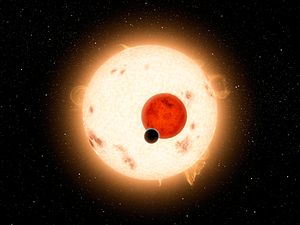Kepler-16b
| Exoplanet | List of exoplanets | |
|---|---|---|
 |
||
| Parent star | ||
| Star | Kepler-16 (KOI-1611) | |
| Constellation | Cygnus | |
| Right ascension | (α) | 19h 16m 18.17s |
| Declination | (δ) | 51° 45′ 26.78″ |
| Apparent magnitude | (mV) | 11.5 |
| Distance | 196 ly (60 pc) |
|
| Spectral type | K / M | |
| Mass | (m) | 0.69 / 0.2026 M☉ |
| Radius | (r) | 0.649 / 0.2262 R☉ |
| Temperature | (T) | 4450 / 3311 K |
| Metallicity | [Fe/H] | −0.3 ± 0.2 (A) |
| Age | ~2 Gyr | |
| Physical characteristics | ||
| Mass | (m) | 0.333 (± 0.015) MJ |
| Radius | (r) | 0.7538 (± 0.0025) RJ |
| Stellar flux | (F⊙) | 0.2993 ⊕ |
| Density | (ρ) | 0.964 (± 0.047) g cm−3 |
| Surface gravity | (g) | 14.52 (± 0.7) m/s² |
| Temperature | (T) | 188 K (−85 °C; −121 °F) K |
| Orbital elements | ||
| Semi-major axis | (a) | 0.7048 ± 0.0011 AU |
| Eccentricity | (e) | 0.0069 ± 0.0015 |
| Orbital period | (P) | 228.776 ± 0.037 d |
| Inclination | (i) | 90.0322 ± 0.0023° |
| Longitude of the node | (Ω) | 0.003 ± 0.013° |
| Argument of periastron |
(ω) | 318 ± 22° |
| Mean longitude | (λ) | 106.51 ± 0.32° |
| Discovery information | ||
| Discovery date | 15 September 2011 | |
| Discoverer(s) | Laurance Doyle | |
| Discovery method | Transit (Kepler Mission) | |
| Other detection methods | Radial velocity, Eclipsing binary timing variations, Transit timing variations |
|
| Discovery status | Published | |
| Database references | ||
| Extrasolar Planets Encyclopaedia |
data | |
| SIMBAD | data | |
| Exoplanet Archive | data | |
| Open Exoplanet Catalogue | data | |
Kepler-16b (formally Kepler-16 (AB)-b) is an extrasolar planet. It is a Saturn-mass planet consisting of half gas and half rock and ice, and it orbits a binary star, Kepler-16, with a period of 229 days. "[It] is the first confirmed, unambiguous example of a circumbinary planet – a planet orbiting not one, but two stars," said Josh Carter of the Harvard-Smithsonian Center for Astrophysics, one of the discovery team.
Kepler-16b was discovered using the space observatory aboard NASA's Kepler spacecraft. Scientists were able to detect Kepler-16b using the transit method, when they noticed the dimming of one of the system's stars even when the other was not eclipsing it. Furthermore, duration of transits and timing all the eclipses and transits of Kepler-16b and its stars in the system has allowed for unusually high precision in the calculations of the sizes and masses of objects in the Kepler-16 system. The leader of Kepler-16b's discovery team, Laurance Doyle of the SETI Institute in Mountain View, California, said of this precision, "I believe this is the best-measured planet outside the solar system.". For example, Kepler-16b's radius is known to within 0.3%, better than that of any other known exoplanet (as of September 2011).
Kepler-16b is also unusual in that it falls inside the radius that was thought to be the inner limit for planet formation in a binary star system. According to Sara Seager, a planetary expert at the Massachusetts Institute of Technology, it was thought that for a planet to have a stable orbit around such a system, it would need to be at least seven times as far from the stars as the stars are from each other. Kepler-16b's orbit is only about half that distance.
...
Wikipedia
